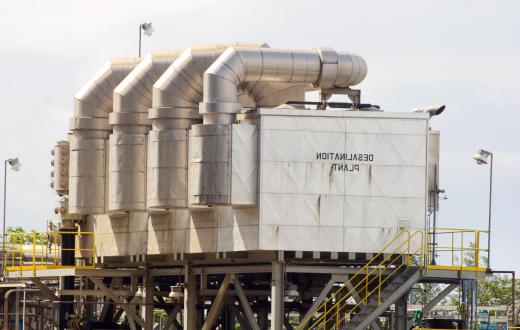A freshwater generator is a machine, usually on board a ship but in some shore-based industrial settings too, that converts salt water from seas and oceans into drinkable fresh water. The machines tend to be quite complex and rely on a series of pumps and pressure chambers as well as high temperatures to prompt both boiling and evaporation. They’re usually somewhat sensitive and often require a lot of maintenance to keep them running efficiently; the salts that are removed from the water can cause build-up, and if sensors measuring relative salinity lose their precision the delivered water won’t be fresh at all. These generators are a very important part of long sea voyages, as it isn’t usually practical for crews to pack all the water that they need. Some communities have also begun building desalination plants to covert seawater to water that can be used in place of municipal water, but the costs here tend to be very high. Researchers have long been looking for economical ways to covert salt water to water that can be readily consumed by people, particularly in drought-ridden parts of the world, but for now at least the practice is so costly that it’s really only used in wealthy areas that can both pay for the initial plant construction and perform needed upkeep.
Basic Concept

The overarching concept of a freshwater generator is usually quite simple. First, sea water is evaporated using a heat source, separating pure water from salt, sediment and other elements. Generators often use the diesel engine jacket as a heat source, although steam can also be used for this purpose. The practicalities are often more complicated. The starting cost tends to be really high, too, but, largely because freshwater generators tend to harness existing heat to run, the realized costs of operation tend to be low — at least on ships. Depending on how much water they need to convert, they also tend to be fairly small, and can usually be contained in a mechanical closet or small room.
Importance of Fresh Water

Ships and ocean liners often take weeks if not months to complete their voyages, and a lot of fresh water is usually required to sustain operations for this long. The crew and passengers need water to drink, certainly, and water is also needed for things like cooking and cleaning. Many mechanical operations, particularly as relates to the engine, also need steam and connection to a water supply in order to maintain optimal operations. Seawater is unsuitable for drinking and cooking, and the sediments it contains usually make it unacceptable for most other uses, too.

Long ago, sea voyagers brought barrels of water that they rationed for the duration of their trip. While this is still usually an option, packing enough clean water at the outset often adds a lot of weight that modern seamen see as unnecessary, and the risks of spoilage aren’t usually worth the costs, either. Investing in a freshwater generator is widely considered industry standard, and is required by most governments and regulatory agencies for commercial operations.
Primary Components

There are two main elements in most generators. One heat exchanger evaporates the sea water, and another condenses the fresh water vapor into drinking water. In the condenser element, the vapor is condensed through cooling, often simply using cold seawater to cool the outside of the unit.
From a practicality perspective, the generator should also include a feature to monitor the salinity of the processed water. If the salinity exceeds a specified level, usually between one and ten parts per million (ppm), the generator will automatically return the water to the feed line and put it through the cycle again. Consistent problems may be a sign of needed repairs.
Use in Desalination Plants
Generator are increasingly used as a core component of large-scale desalination plants, typically located in coastal areas; these plants are usually designed to provide small quantities of fresh drinking water and crop irrigation to the local community. These have become very common in the Middle East, and are also in use in some California communities. More desalination plants are likely to be built in response to drought and as concerns over availability of water in growing cities continue to rise. However, the costs involved in desalination plants tend to be very high. As such, they are usually considered only when wealthy communities are faced with water shortages from traditional sources, and usually only in places that have a natural saltwater source already.
Practical Restrictions for Everyday Use
Researchers and environmental experts have long questioned the sustainability of fresh water sources on earth, and many have been looking for an inexpensive and reliable way to convert salt water for human use. In most cases, generators aren’t powerful enough to meet the scope of the need, even if they weren’t so very expensive to operate on land.
Many of the most desperate water-poor communities are far inland, often in war-ravaged or developing countries; many of the regions in central Africa are good examples. Building desalination plants here isn’t feasible because there isn’t a ready source of salt water, and trucking it in from the coast is often prohibitively expensive. As such, generators are a means of converting water, but they aren’t usually thought of as a solution to widespread water shortage.
